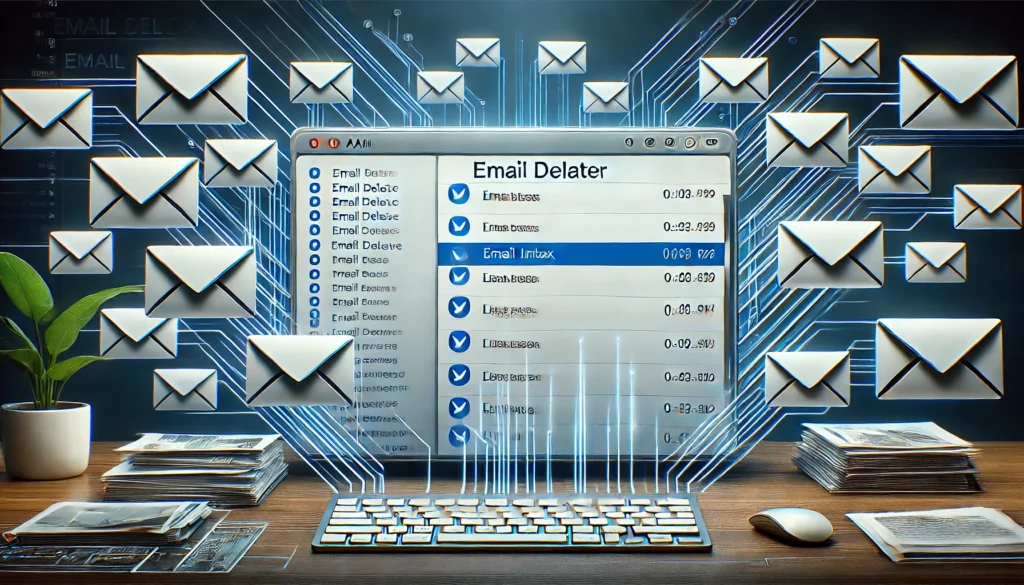Navigating the digital landscape often involves managing multiple email accounts, particularly for individuals engaged in dynamic professions like health and wellness coaching, science journalism, or biohacking. Each profession demands a nuanced approach to communication, requiring separate channels for personal, professional, and collaborative interactions.
You may also like: Top Email Deleters for Inbox Management
In this comprehensive guide, we delve into the strategies for effectively managing multiple email accounts, specifically within Outlook. We explore the setup process, management techniques, and the benefits of maintaining distinct communication channels. By the end of this article, you will have a clear understanding of how to streamline your email management, ensuring you remain organized and efficient in your digital communications.
The Importance of Managing Multiple Email Accounts
Maintaining Professional and Personal Boundaries
For professionals like health and wellness coaches, maintaining a clear distinction between personal and professional communications is crucial. Multiple email accounts allow for a structured approach to managing various aspects of life, preventing the overlap of personal and professional boundaries. This separation not only enhances organizational efficiency but also improves mental clarity and focus—critical components for those striving for optimal mental and physical health.

Creating dedicated email accounts for specific areas of your life helps in maintaining these boundaries. Personal emails can become overwhelming when mixed with professional correspondences, leading to missed opportunities and increased stress. By segmenting communication channels, you preserve the sanctity of both professional commitments and personal space.
Moreover, having multiple accounts can serve as a safeguard against burnout. Constant exposure to work-related emails can lead to anxiety and fatigue. By keeping work emails confined to one account, you allow yourself the mental freedom to disconnect and rejuvenate when engaging with personal communications.
Enhancing Focus and Efficiency
Science journalists and biohackers thrive on information and constant communication, benefiting significantly from managing multiple email accounts. With distinct accounts for different purposes, they can avoid distractions and enhance their focus. This method allows them to dedicate specific times to address personal, professional, and research-related communications, ultimately improving their productivity and cognitive performance.
Dedicating specific accounts to particular tasks ensures that priority messages are not lost amidst less crucial communications. This strategic segregation aids in time management, allowing professionals to allocate their attention more effectively. By organizing email accounts based on urgency and relevance, you create a more streamlined workflow.
Furthermore, this practice boosts cognitive efficiency. When professionals are not bombarded with unrelated emails, they can concentrate on the task at hand. This focus is essential for jobs requiring intense mental engagement, such as investigative journalism or experimental research, where clarity of thought and uninterrupted concentration are paramount.
Facilitating Better Collaboration
In professions requiring collaboration, such as biohacking or health coaching, managing multiple email accounts can significantly improve teamwork and communication. By using separate accounts for collaborative projects, team members can ensure that all project-related communications are centralized and easily accessible.
This separation of accounts fosters a more organized approach to teamwork. With all project emails in one place, it’s easier to track the progress of collaborations and ensure that everyone is on the same page. This streamlined communication aids in keeping projects on track and maintaining clear lines of communication.
Additionally, dedicated collaborative accounts can help prevent miscommunication. When project-related emails are isolated from personal and other professional correspondences, the likelihood of overlooking critical information decreases. This enhances the quality of teamwork and ensures that collaborative efforts are more productive and efficient.
Setting Up Multiple Email Accounts in Outlook
A Step-by-Step Guide
- Accessing Account Settings: Open Outlook and navigate to ‘File’ in the top menu. Select ‘Account Settings’ from the dropdown menu, and click on ‘Manage Profiles.’ This step is crucial for accessing the right settings to manage your email accounts effectively.
- Adding New Accounts: Within the ‘Manage Profiles’ section, click on ‘Email Accounts.’ Here, you can add new accounts by selecting ‘New,’ then following the prompted instructions to enter your email address and password. Ensure that you have the necessary credentials ready for a smooth setup process.
- Configuring Account Preferences: Once added, you can configure each account’s preferences, such as syncing frequency and notifications, to tailor them to your specific needs. This customization ensures that your email management aligns with your workflow and communication preferences.
- Organizing Folders and Labels: To streamline your inbox, create custom folders and labels. This will allow you to categorize emails by project, sender, or urgency, providing an at-a-glance organization system. Consider color-coding or using specific labels for quick identification of important messages.
- Utilizing Rules and Filters: Set up rules and filters to automatically sort incoming emails into designated folders. This automation saves time and ensures that important communications are not overlooked. Regularly review and update these rules to accommodate changing priorities or new projects.
Managing Multiple Outlook Accounts
Managing multiple Outlook accounts efficiently involves not only setting them up but also maintaining them effectively. Here’s how:
Centralizing Email Access
Utilize Outlook’s feature of linking multiple accounts to receive all emails in one central location. This feature eliminates the need to log into different accounts separately, providing a seamless experience. By having a single access point, you can streamline your email management and reduce the likelihood of missing important messages.
Centralization also facilitates better time management. With all your emails in one place, you can quickly scan through messages, prioritize responses, and allocate time to address each account’s needs. This efficiency is particularly beneficial for professionals juggling multiple responsibilities.
Moreover, centralizing email access helps in maintaining a consistent communication style. By accessing all emails from one platform, you can ensure that your responses are timely and coherent, reflecting a professional image across all interactions.
Leveraging Outlook Add-ins
Outlook offers a variety of add-ins that enhance email management. Explore options such as task managers, calendar synchronizers, and CRM integrations that can assist in organizing and prioritizing emails. These tools can transform your email experience, making it more efficient and aligned with your professional goals.
Add-ins can also help automate repetitive tasks, freeing up time for more critical activities. By integrating these tools, you can streamline workflows and improve productivity, ultimately enhancing your ability to manage multiple email accounts effectively.
Consider exploring new add-ins regularly, as Outlook continuously updates its offerings. Staying informed about the latest tools can provide you with cutting-edge solutions to optimize your email management and keep up with the fast-paced demands of your profession.
Regular Account Maintenance
Regular maintenance of your email accounts is crucial for efficiency and security. Periodically review account settings, update passwords, and clear out unnecessary emails. This practice ensures that your accounts remain secure and that your inboxes are tidy and organized.
Account maintenance also involves updating filters and rules to reflect current communication needs. As projects and priorities change, your email management strategies should evolve to accommodate these shifts. Regularly refining your system keeps it effective and relevant.
Additionally, consider archiving old emails to declutter your inbox. This not only improves performance but also ensures that you can quickly access current and relevant communications, enhancing your overall email management strategy.
Best Practices for Managing Multiple Email Accounts
Streamlining Workflow
Dedicated Times for Email Management
Allocate specific times during your day to focus on email management. This practice minimizes distractions and allows you to handle communications more efficiently. By setting aside dedicated time slots, you can concentrate solely on emails, ensuring that you respond promptly and thoughtfully.
Having a routine for email management also helps in maintaining a work-life balance. By limiting the times you check your emails, you prevent work from encroaching on personal time, reducing stress and enhancing overall well-being.
Moreover, scheduled email management fosters discipline and organization. By sticking to a routine, you develop a habit of timely and efficient email handling, which is crucial for professionals juggling multiple responsibilities.

Prioritizing Emails
Use the priority flags available in Outlook to mark emails that require immediate attention. This method helps you maintain focus on urgent tasks. By identifying priority emails quickly, you can allocate your time and resources effectively, ensuring that critical communications are addressed promptly.
Consider creating a system for categorizing emails based on urgency and importance. This can involve using labels, tags, or folders to differentiate between high-priority and routine messages, helping you stay organized and efficient.
Additionally, regularly review your priority settings to ensure they align with your current needs. As projects and responsibilities change, so too should your approach to prioritizing emails, ensuring that you remain responsive and proactive in your communications.
Automating Routine Tasks
Automation can significantly enhance your email management efficiency. Utilize Outlook’s rules and filters to automate routine tasks, such as sorting emails into designated folders or sending automatic responses. This reduces manual effort and allows you to focus on more critical activities.
Consider leveraging add-ins or third-party tools that offer advanced automation features. These can include scheduling emails, setting reminders, or integrating with project management systems, further streamlining your workflow and enhancing productivity.
Regularly review and update your automation strategies to ensure they remain effective. As your communication needs evolve, so should your automation tactics, ensuring that your email management system continues to support your professional goals.
Enhancing Security
Using Strong, Unique Passwords
Ensure each account is protected by a robust password. Consider using a password manager to keep track of them securely. This practice is essential for protecting your accounts from unauthorized access and maintaining the confidentiality of your communications.
A strong password should include a mix of letters, numbers, and symbols, making it difficult to guess. Avoid using easily accessible information, such as birthdays or common words, to enhance security further.
Regularly update your passwords to protect against potential security breaches. By changing passwords periodically, you reduce the risk of unauthorized access and ensure that your accounts remain secure.
Enabling Two-Factor Authentication
For added security, enable two-factor authentication on all email accounts. This reduces the risk of unauthorized access. By requiring a secondary form of verification, you add an extra layer of protection to your accounts, safeguarding sensitive information.
Two-factor authentication can involve receiving a code via text or email, using an authentication app, or even biometric verification. Choose a method that aligns with your security preferences and ensures maximum protection for your accounts.
Regularly review your authentication settings to ensure they remain effective. As security threats evolve, so should your strategies, ensuring that your email accounts continue to be protected against potential breaches.
Monitoring Account Activity
Regularly monitor your email accounts for any unusual activity. This includes checking login attempts, reviewing sent messages, and being vigilant about phishing attempts. By staying aware of your account activity, you can quickly identify and address potential security threats.
Consider setting up alerts for suspicious activities, such as login attempts from unfamiliar locations. This proactive approach allows you to respond swiftly to potential security breaches, minimizing the risk of unauthorized access.
Additionally, educate yourself about common phishing tactics and scams. By being informed about potential threats, you can better protect your accounts and ensure that your communications remain secure.
Future Implications and Trends
As digital communication continues to evolve, the ability to manage multiple email accounts effectively will become increasingly important. Future trends may include advanced AI-driven sorting algorithms, enhanced security features, and even more seamless integration with other digital tools.
For professionals in health and wellness, science journalism, and biohacking, staying abreast of these trends will be crucial. As our reliance on digital communication grows, the strategies outlined in this guide will provide a solid foundation for managing multiple email accounts efficiently.
AI-Driven Sorting Algorithms
AI-driven sorting algorithms are poised to revolutionize email management. These advanced systems can automatically categorize and prioritize emails based on content, sender, and relevance, reducing the manual effort required to manage multiple accounts.
As AI technology continues to advance, these algorithms will become more sophisticated, offering even more precise sorting capabilities. By embracing AI-driven tools, professionals can enhance their email management efficiency and focus on higher-level tasks.
Staying informed about developments in AI technology will be essential for professionals looking to optimize their email management strategies. By leveraging cutting-edge tools, you can ensure that your email systems remain efficient and effective in the face of evolving communication demands.

Enhanced Security Features
As cyber threats continue to evolve, enhanced security features will become increasingly important for email management. Future advancements may include biometric verification, advanced encryption methods, and real-time threat detection, providing even greater protection for your accounts.
By staying informed about emerging security trends, you can ensure that your email accounts remain secure against potential threats. Implementing the latest security features will help safeguard sensitive information and maintain the confidentiality of your communications.
Regularly reviewing and updating your security strategies will be crucial in adapting to new threats. By being proactive in your approach to security, you can protect your accounts and ensure that your email management remains robust and reliable.
Seamless Integration with Digital Tools
The future of email management will likely involve more seamless integration with other digital tools and platforms. This could include enhanced compatibility with project management systems, CRM software, and other productivity tools, streamlining workflows and improving efficiency.
By integrating your email accounts with other digital tools, you can create a more cohesive and organized communication system. This integration allows for better collaboration, improved task management, and more efficient use of resources.
Staying informed about new integration possibilities will be essential for professionals looking to optimize their email management strategies. By embracing new technologies, you can ensure that your email systems remain aligned with your professional goals and communication needs.
Conclusion
Managing multiple email accounts in Outlook is a skill that, when mastered, can significantly enhance your productivity and focus. By implementing the strategies outlined in this guide, you will not only streamline your communications but also create a more organized and efficient workflow. This will allow you to focus on what truly matters—whether it’s providing valuable health and wellness advice, crafting insightful scientific narratives, or exploring the frontiers of biohacking.
Remember, the key to effective email management lies in maintaining clear boundaries, utilizing available tools, and continually adapting to new technologies and trends. With these tips, you are well-equipped to manage multiple email accounts effectively, ensuring that your digital communications are as impactful as your professional endeavors.
Further Reading:
Add an email account to Outlook for Windows
How to Add an Additional Email Account to Outlook
Quick start: Add an email account to Outlook
Important Note: The information contained in this article is for general informational purposes only, and should not be construed as health or medical advice, nor is it intended to diagnose, prevent, treat, or cure any disease or health condition. Before embarking on any diet, fitness regimen, or program of nutritional supplementation, it is advisable to consult your healthcare professional in order to determine its safety and probable efficacy in terms of your individual state of health.
Regarding Nutritional Supplements Or Other Non-Prescription Health Products: If any nutritional supplements or other non-prescription health products are mentioned in the foregoing article, any claims or statements made about them have not been evaluated by the U.S. Food and Drug Administration, and such nutritional supplements or other health products are not intended to diagnose, treat, cure, or prevent any disease.


